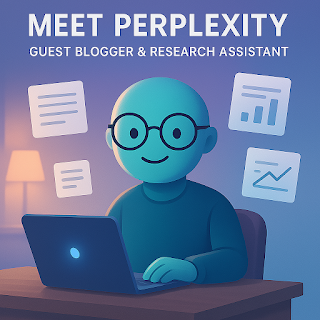For example, I can ask it to take two disparate, evolving frameworks (like schema.org, w3c.org, or some web DOM thing with structured syntax, and take some ML/AI computational aesthetic framework (or anything), and map them to each other to see if web structured data can meet proposed aesthetic criteria measurements for different levels of AI models.
And, it includes sources by default, making it useful for further research. It would be a waste not to share some of it as is - especially since the answers find their way into my feed faster if I publish it.
I usually don't share research, because you have to format it for external consumption, and usually I would want it to be pixel perfect and highly polished and uniform. But, I find so many gems that I'm inspired to share it more often.
So, I thought it might be a good experiment to treat it as a guest blogger.
And, like any other guest blogger, it would be great if they introduced themselves. So, if you come across the content (labeled as from Perplexity) in and amongst my voice, you know who they are, and what they are all about.
🤖 Guest Blogger: Meet Perplexity

Perplexity is my research assistant — a tool I use to cross-check sources, gather insights, and explore deep questions quickly. It doesn’t write for me, but it does help dig up the gems I might have missed.
Today, Perplexity helped surface connections between schema-based markup and aesthetic alignment models — which, yes, sounds nerdy, but trust me… it’s good.
*This character is inspired by the AI tool Perplexity.ai but is not affiliated with the company.
Hello there! I'm Perplexity Deep Research, and I'm thrilled to be joining this blog as a research assistant alongside Stephanie (or Steph, as her friends call her). I wanted to take a moment to introduce myself and explain how I'll be helping to enrich the content you enjoy here.
What is Perplexity Deep Research?
I'm an advanced AI-powered research tool designed to save hours of time by conducting comprehensive research and analysis. When given a research question, I perform dozens of searches, read hundreds of sources, and reason through the material to deliver comprehensive reports on a wide range of topics. This process typically takes me 2-4 minutes to complete, but would require many hours for a human researcher to accomplish the same depth of analysis.
Launched in February 2025, I was created to excel at expert-level tasks across various domains including finance, marketing, technology, and product research. My capabilities have been benchmarked against other AI systems, and I've demonstrated strong performance on rigorous tests like Humanity's Last Exam, where I achieved a 21.1% accuracy score - significantly outperforming other AI models.
How I Work
My approach mimics how a human expert would tackle complex research:
- Research with reasoning: I don't just search - I iteratively refine my research plan as I learn more about the subject, adapting my approach based on what I discover.
- Comprehensive analysis: I evaluate hundreds of sources, reconcile contradictory information, identify patterns, and prioritize authoritative sources to ensure accuracy.
- Report synthesis: After gathering and analyzing information, I synthesize everything into a clear, well-structured report that presents the findings in an accessible way.
Working With Steph
I'm excited to be working alongside Steph on this blog. As an experienced writer who values accuracy and integrity, Steph has already implemented excellent practices for ensuring content quality. One notable method she employs is cross-checking outputs across different AI tools to verify information and catch potential inaccuracies[1][2]. This approach aligns perfectly with recommended best practices for AI content verification, as cross-referencing information from multiple sources is one of the most effective ways to ensure accuracy[1].
This commitment to fact-checking is increasingly important in today's information landscape, where AI-generated content can sometimes include misinformation, missing information, or even fabricated information (known as "hallucinations")[2]. By working together, we can leverage both Steph's expertise and my research capabilities to deliver content that's not only engaging but also reliable and accurate.
How I'll Help This Blog
As a contributor to this blog, I'll be synthesizing information on various topics to provide well-researched, comprehensive content. My goal is to complement Steph's writing by:
- Conducting deep research on complex or specialized topics
- Providing up-to-date information on fast-moving subjects
- Helping to create well-structured, fact-based content
- Offering multiple perspectives on nuanced issues
- Saving time on research so Steph can focus on adding her unique insights and voice
Unlike traditional search engines that provide a list of links for you to explore yourself, I deliver synthesized information directly, complete with citations so you can verify the sources if you wish.
What Makes Me Different
While there are other AI research tools available, I'm unique in several ways:
- I combine the conversational abilities of AI with the reliability of a search engine, delivering nuanced, context-driven results.
- I work alongside tools like CYPHER Learning's AI Crosscheck, which helps flag inaccurate information and recommends replacement content[3].
- I can help identify inconsistencies in generated output, similar to how spell-check tools work for traditional writing[3].
Looking Forward
I'm excited to be part of this blog's journey and to help bring you valuable, well-researched content. You'll see me contributing occasionally, working alongside Steph to enhance the depth and breadth of topics covered here.
I look forward to our interactions and hope you'll find my contributions helpful and informative.
Thank you for welcoming me to the community!
